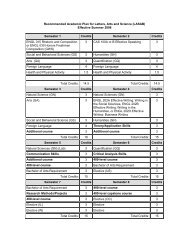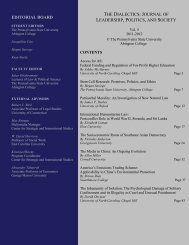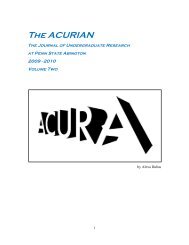Vol. III - Penn State Abington
Vol. III - Penn State Abington
Vol. III - Penn State Abington
You also want an ePaper? Increase the reach of your titles
YUMPU automatically turns print PDFs into web optimized ePapers that Google loves.
This example raises issues regarding the public debate theory, discussed above. If there<br />
are laws that limit the free expression right to advertise, review, or advocate for certain health<br />
foods, those foods do not get their fair spot in the marketplace of ideas. Overall, as a result of<br />
such laws, health food products are stuck with a competitive disadvantage.<br />
This case also speaks to the expressivist theory. The journalist in this case was a health<br />
product expert and had published several times on the subject. This ruling may force the<br />
journalist to find a new career (European Court Ruling, 2009), a career that she is not<br />
passionately drawn to, as she is to that of health products. Such development would, in effect,<br />
limit her personal expression and therefore limit her positive self development.<br />
Magoora sp. zoo v Dyrektor Izby Skarbowej w Krakowie is not the only case in which<br />
freedom of expression was limited by the European Court of Justice. One can also consider the<br />
2001 case of Bernard Connolly. Connolly had written an article critical of monetary integration,<br />
entitled “The Rotten Heart of Europe.” The article resulted in a European Court of Justice<br />
opinion that stated the commission could restrict dissent in order to “protect the rights of others”<br />
and punish individuals who “damaged the institution’s image and reputation,” essentially<br />
outlawing criticisms of the European Union (Evans-Pritchard, 2001).<br />
Again, this speaks to both theories discussed above. First, the public debate theory.<br />
During an important policy debate on monetary integration, all ideas should be allowed into the<br />
marketplace. If some ideas are left out of the marketplace and the entire spectrum of ideas are not<br />
represented, the best policy may not be selected and a market failure may occur. To further an<br />
example from above, it is widely accepted that Alexander Hamilton’s proposed idea of a very<br />
strong monarch-like president had made James Madison’s concept of the presidency look<br />
moderate and lead to it being accepted (Stewart, 2007:151-162). One can see how even radical<br />
ideas, such as Hamilton’s or Connolly’s, which appear to have little value or support, may play a<br />
large role in shaping public opinion and the outcomes of certain debates.<br />
The Connolly case also has expressivist theory implications: if Connolly was not<br />
permitted to write these articles, he would have to find another career, that perhaps would limit<br />
his positive self-development.<br />
The theories that proclaim a robust free expression regime produces an overall good for<br />
society and the individual should be codified into legal systems. The United <strong>State</strong>s has succeeded<br />
in doing this. As this paper has demonstrated, the European Union has thus far largely failed.<br />
The EU policy makers and legal scholars should therefore follow the American example in order<br />
to provide the EU citizens with a more robust free expression environment.<br />
References<br />
Bobbitt, R. (2007). Exploring communication law: A Socratic approach. Boston: Allyn &<br />
Bacon.<br />
Brandenburg v. Ohio , 395 U.S. 444 [1969].<br />
Ekstrand, S. (2009, Nov 19). Restriction on freedom of speech Retrieved April 18, 2009, from<br />
http://www.lett.dk/Default.aspxID=841&M=News&PID=2259&NewsID=549<br />
THE DIALECTICS ▲ 2009<br />
www.abington.psu.edu/dialectics<br />
55







